The Epic Death Of The Mad King Of Lake Michigan
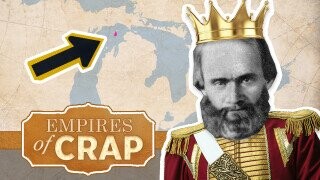
Welcome to Empires of Crap, Cracked's semi-regular exploration of would-be god-emperors who immediately pooped the bed. Today's topic: James Strang, the Mad King of Lake Michigan.
In the 1770s, Americans rose up against the ruthless oppression of King George III, who managed to become history's most terrifying tyrant despite spending most of his time in a straight jacket being rubbed with various sandwich spreads in the hope that they would cure his brain worms. Since then, the country has historically been seen as opposed to a monarchy. But over the years, a surprising number of Americans have tried to set themselves up as kings and queens, and we're going to be looking at one of the most successful ...
The Paper Crown Of Beaver Island
Don't Miss
These days, Lake Michigan is known as the greatest of the Great Lakes, in the sense that it's the only one Canada isn't allowed to rub up on. Huge crowds flock to its beaches every year, hoping for the classic Lake Michigan experience (seeing a confused tourist lose control of a jet ski and get catapulted headfirst into a trout). But back in 1856, an even more compelling drama was taking place as the Navy's USS Michigan steamed across the lake and moored at the neat little dock on Beaver Island. The warship had come to seek an audience with King Strang, the self-declared prophet who ruled the island with an iron fist. But as Strang walked down to the dock, he was unaware that hidden gunmen had taken up position in the local general store, waiting for his approach.
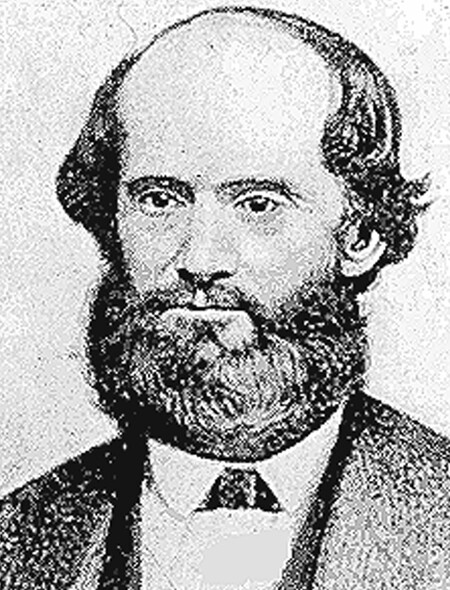
Six years earlier, Strang had been crowned king in a solemn ceremony held in the island's small tabernacle, which had been painted to look like a palace for the occasion. The new king wore a robe of flannel hastily dyed red and a tin sword around his waist. As he sonorously proclaimed himself "King of Judah," a member of his elite Halcyon Order of the Illuminati stepped forward and placed a paper crown decorated with glass stars on his head. Frankly, we wouldn't be surprised to learn that the whole island was made of cardboard at this point. Yet, despite borrowing all their decorating tips from a middle school production of Spamalot, there's no doubt that everyone involved took the coronation entirely seriously -- a fact underscored by the loaded cannon placed just outside the building.
But by 1856, Strang's hold on his subjects was beginning to weaken. As he approached the dock, two disgruntled former followers stepped out from the general store and shot him in the back of the head. They followed up by pistol-whipping him and shooting him twice more in the face and ribs as he lay on the ground. The assassins then raced aboard the Michigan, which refused to surrender them to the local authorities. Instead, the warship dropped them off on nearby Mackinac Island, where they were celebrated as heroes for killing the hated priest-king. Three weeks later, a fleet of heavily armed fishing boats set off from Mackinac and landed on Beaver Island, carrying an angry mob that rampaged through the island, forcing Strang's 2,000 remaining followers to flee to the mainland, never to return. Continental America's last functional monarchy had been extinguished.

But who was James Jesse Strang? How did he wind up ruling as king over an island of just 55 square miles? And why did so many people hate his guts that the US Navy would end up acting as getaway drivers for his murder? Well, to understand the Mad King, we have to go back to 1844, when the murder of another prophet created the chaos that allowed Strang's rise to power.
Fear The Final Crisis
Mormonism was founded in the 1820s after a young farmer named Joseph Smith reported experiencing a series of heavenly visions. These culminated in the appearance of an angel named Moroni, who informed Smith that a set of golden plates inscribed with the wisdom of the ancients were buried under a nearby hill. After basically jerking Smith around for a few years, Moroni finally allowed him to retrieve the plates (which involved a surprisingly epic kung fu battle against three mysterious assailants). The plates turned out to contain a series of strange revelations, including that ancient Jews had traveled from Jerusalem to America, that their civilization had ultimately destroyed itself in a mighty war between "Nephites" and "Lamanites," and that Jell-O was a perfectly acceptable salad ingredient.

Now, your belief in the Book of Mormon will obviously vary depending on whether or not you're currently a member of Imagine Dragons. But in the early 19th century, Americans were almost alarmingly receptive to new ideas. There was a flourishing of religious groups like the Millerites, who managed to convince so much of the country that the world would end on October 22, 1844, that the date was ever after remembered as the "Great Disappointment." Meanwhile, a military veteran named John Symmes toured the country, proclaiming his belief that the world was hollow. Despite a complete lack of evidence, he managed to get so much traction that the US government briefly backed an expedition to the center of the Earth.
In rural New York, the Oneida Community encouraged free love, as well as a form of birth control where men were instructed to enjoy "the simple presence the reciprocal motion" of sex but strictly forbidden from the "final crisis" of ejaculation. In Indiana, the equally popular Harmony Society rejected such holy edging in favor of complete celibacy but ultimately split apart after being hoodwinked by the self-proclaimed "Count de Leon." The alchemist and magician who convinced a third of the Society to follow him to a more sex-positive life in a Louisiana swamp, where he promptly died of swamp-based diseases. Fortunately, the remaining Harmonists were able to sell their town to one of the utopian socialist communes that were popping up across the midwest. It was as if the whole country was desperately searching for some new calling.
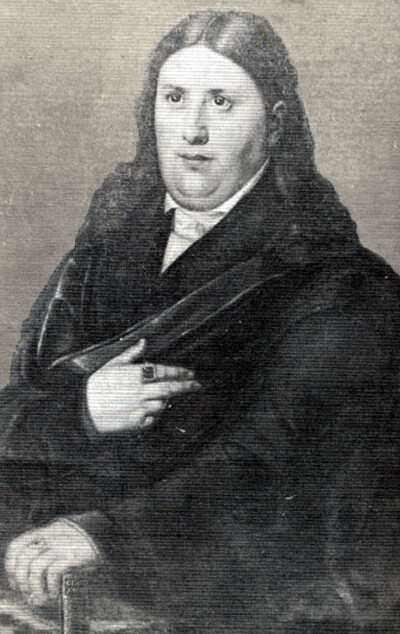
In this receptive environment, Mormonism quickly attracted tens of thousands of followers. However, theological differences led to some polite disagreements between the Latter-Day Saints and their gentile neighbors, which escalated until Joseph Smith was politely riddled with bullets by a mob in 1844. With no obvious successor, Mormonism was plunged into a power struggle between various senior figures. Key contenders included Apostle Brigham Young, First Counselor Sidney Rigdon, and Smith's 11-year-old son. One guy almost nobody expected to get involved was James Strang, a complete rando who had only recently converted to Mormonism. We say "almost nobody" because Strang himself had very strong ideas about his own greatness and was about to prove more dangerous than anybody could have predicted.
Faked Deaths And The Rajahs Of Old Wisconsin
James Strang was born in upstate New York in 1813 and apparently died there in 1843, when his torn coat and hat were found hidden in some bushes, with the surrounding leaves "so stirred up as to convey the impression that there had been a severe struggle, and the suspicion of murder." In fact, Strang was a small-time scammer who had faked his own death and skipped town to avoid his creditors, a scheme that was admittedly much easier in the days when a few kicked up leaves were considered clear evidence that the hill people had claimed another victim. Strang reappeared in Burlington, Wisconsin, where he set himself up as a lawyer and quickly made a name for himself by suing some bees for stealing honey from a rival hive.
In 1844, Strang converted to Mormonism, most likely as a ploy to attract settlers for some land he owned outside Burlington. Smith was murdered a few months later, at which point Strang announced that he was the new leader of the church. Nobody knew what to make of this. It was like a guy taking first communion and instantly declaring himself pope. But Strang had powerful evidence to support his claim in the form of a letter from Joseph Smith, declaring Strang as his divinely appointed heir. Sadly, it seemed that Smith was so absent-minded that he failed to mention this letter to anyone else and even forgot what his own handwriting and signature looked like while writing it. What a scatterbrain!
Sensing that few god-kings are anointed by post, Strang decided to up his game. In 1845, he announced that the same angel who visited Joseph Smith had returned to show him the location of even more hidden plates of ancient wisdom. Unfortunately, the ancients had apparently had some budget cuts in the interim since Strang's plates were made of brass instead of gold, were small enough to fit in the palm of his hand, and generally appeared to have been made out of an old tea kettle. Undeterred, Strang set about deciphering the wisdom of these broke-ass elders. He ultimately announced that the plates had been written by Rajah Manchou of Vorito, who had ruled over a primordial empire in the greater Burlington area. The Rajah had eventually seen his people destroyed by whatever catastrophe created modern Wisconsin, but he found time to bury a prophecy of Strang's coming under the hill before expiring.

Now, how credible you find all that probably depends on how recently you got your head caught in a stepladder, but as we've seen, it was an era searching for something to believe in. Strang immediately attracted thousands of followers, and the Mormon movement split into competing churches led by Strang and Brigham Young. Strang took the schism with good grace, simply saying that he hoped Young's followers "may see their bones rot in the living tomb of their flesh; their flesh generate from its own corruptions a loathesome life for others; their blood swarm with a leprous life of motelike, ghastly corruption feeding on flowing life, generating chilling agues and burning fevers. May peace and home be names forgotten to them; and the beauty they have betrayed to infamy, may it be to their eyes a crawling mass of putridity." Which sounds bad now, but we're pretty sure it actually describes the picture of good health in the 1840s, when the average person was a dung-coated battleground between various tapeworm civilizations.
But the anti-Mormon sentiment that led to Smith's murder remained at boiling point, and Strang soon started to feet the heat. As Young's followers set off for the long trek to Utah, Strang realized that he was going to need his own remote fortress to hole up in. Fortunately, he remembered passing the perfect place on a ferry years earlier. Its name was Beaver Island.
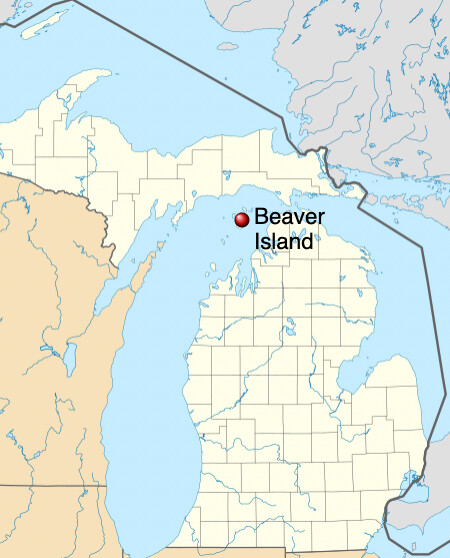
The Battle For Big Beaver
Beaver Island, also known as Big Beaver, is a large, fertile island in northern Lake Michigan. In 1848, it was populated by a handful of Irish fishermen and about 20 Native American families. Strang hit the place like a hurricane, rapidly moving almost 2,000 of his followers to the island. The Strangites simply seized any unoccupied land, correctly believing that the US government would eventually give them squatters' rights. Most of the fishermen found themselves forced out, while Strang launched a remarkably unsuccessful mission to convert the Native Americans.
This was all watched with horror by the inhabitants of neighboring Mackinac Island, who had been accustomed to dominating trade on the lake. Not only did the new arrivals threaten to muscle them out of the growing fishing industry, but Strang also tried to ban the sale of alcohol to the Natives, threatening the Mackinac traders' god-given right to trade five cents worth of whiskey for 50 cents worth of fish. Strang also gave his followers the right to seize, or "consecrate," any unattended gentile fishing nets. The confrontation was inevitable, and Strang failed to cool tensions by declaring, "I will execute with my own hand the sentence of death against all…who attempt to disturb us…I wish all men to understand that we do not hold these lands by right of any government." Before long, the two islands were at war.
In 1850, for instance, a flotilla of boats set out from Mackinaw with the attention of launching an attack on the Strangites. But Strang had been forewarned and was ready to unveil his secret weapon: a powerful new cannon that sent a "salute" skipping across the water, prompting the fleet to turn back in awe to Mackinaw. On another occasion, two boats of Mormons pulled up at the mainland settlement of Pine River, only to be ambushed by local fishermen. With half of their oarsmen badly wounded, the Strangites jumped back in their boats and made for safety. But the gentiles pursued, and both groups frantically rowed for miles across the lake as bullets whizzed back and forth. Just as the Strangites were about to be overtaken and massacred, a Chicago-Buffalo steamship appeared on the scene and allowed them to scramble aboard. The Pine River settlement was immediately abandoned for fear of retribution as the Strangites fanned out across the lake, seizing fishing catches and flogging those who protested.
Both sides appealed to the federal government for support. Unfortunately, for Strang, President Millard Fillmore was staying in his brother's spare room in Detroit (being president was more of a part-time gig in those days) and had been hearing horror stories about the pirate Mormons of Lake Michigan for some time. He ordered the USS Michigan to arrest Strang and bring him to the mainland for trial. But like everything else in Millard Fillmore's life, this backfired badly. Strang's impassioned defense of religious freedom won admirers across the country and persuaded a jury to acquit him of all charges. Strang emerged more powerful than ever. He was even elected to the Michigan State House, which ruled that it could allow a self-proclaimed king to serve as a state representative. And it was at this point that he started to go a bit insane.

The Mad King And His Sex Nephew Elvira
In 1850, Strang informed his 12,000 followers that he was to be crowned king of Beaver Island. This was arguably the culmination of his life's work -- ever since he was a boy, he had dreamed of ruling as a king. At the age of 19, he even spent an entire day trying to come up with a plan to meet and marry the heir to the British throne, even though the future Queen Victoria would definitely have been harrumphed out of the country had she even suggested wedding some random American farm boy. Shortly after founding his church, Strang had established a secret society called the Halcyon Order of the Illuminati, which worked to pave the way for his kingdom. And even though Beaver Island was a little smaller than Great Britain, he actually achieved his childhood dream of a monarchy. Which is when everything started to fall apart.
The first problem involved his nephew and personal secretary, Charles Douglas, who had become the king's closest confidante. As it turned out, Douglas was actually a 19-year-old girl named Elvira Field who Strang had cunningly disguised as his nephew so he could cheat on his wife undetected. Because when you're having an affair, the best way to throw off suspicion is to convince people you're just tongue kissing your teenage nephew instead. When this cunning ruse inexplicably failed to work out, Strang decided to throw caution to the wind and just legalize polygamy so he could marry Elvira.

This was probably not a great move since Strang had spent years positioning himself as the non-polygamist Mormon leader, accusing Brigham Young of being a sex-mad probable rapist, at least one word of which is unfair. The sudden swerve from that to "oh yeah, we're also doing polygamy now" was so whiplash-inducing that the entire Great Lakes region rotated 30 degrees under the pressure. To really rub it in, Strang promptly married not just Elvira but two other teenagers as well. And it's not a great sign when your king and prophet is driving around in the horse and buggy version of a windowless van looking for new wives.
At the same time, Strang had become paranoid and was prone to turning on his closest followers. One of the first victims was Dr. John C. Bennett, the leader of the Illuminati. Bennett had been one of Joseph Smith's closest associates until he was expelled from the church for allegedly making up fake prophecies from Smith to persuade women to sleep with him (only Smith got to pull that move). Bennett subsequently alleged that Smith had sent a team of assassins to kill him but survived to join Strang's group, where he continued his womanizing (and mananizing) ways until Strang also excommunicated him. Next to go was Strang's "prime minister" George Adams, a flamboyant retired actor, and drunk who was kicked out of the church for cavorting with prostitutes in 1841 (an unrepentant Adams promptly hit the stage telling salacious stories about Strang's polygamy). More followed until most of Strang's closest associates were forced out.

Meanwhile, Strang's rule over Beaver Island became increasingly tyrannical. Believers found themselves living in poverty, tithing heavily to the church, and facing brutal whippings for minor offenses. In 1856, Strang kicked out another key lieutenant, Dr. Hezekiah McCulloch. Dr. McCulloch was officially kicked out for a number of offenses, chiefly that his wife refused to wear bloomers underneath her skirt, although his real crime was clearly having a name too old-timey for even the 1850s. Unfortunately for Strang, McColloch decided to seek revenge and recruited two hitmen from the island's disgruntled congregation. He even managed to lure the USS Michigan back to Beaver Island to provide a getaway route. Strang was shot down, and his demoralized followers were ruthlessly cleansed from the island by the Mackinaw mob. So ended the last kingdom in the continental United States.
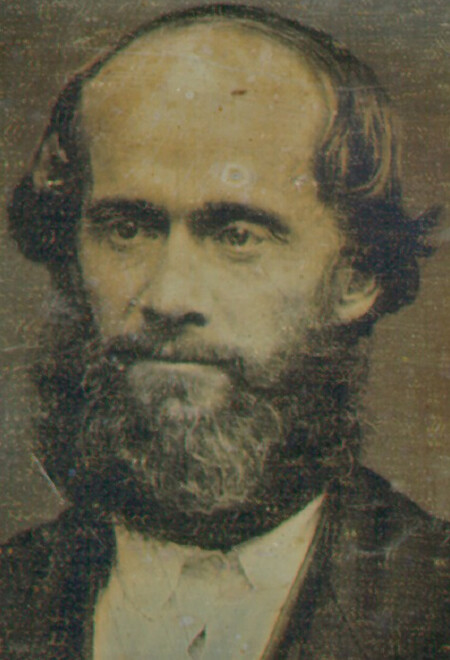
Ultimately, Strang's life has gone down as a budget knockoff of Joseph Smith's. Both found ancient plates, but Strang's were brass and Smith's were gold. Both were assassinated, but Smith died facing down an angry mob, while Strang was shot in the back by his own exhausted followers. Both founded religious movements, but only one lasted. Even Strang's one attempt to differentiate himself from Smith -- his condemnation of polygamy -- proved too much for him to keep up. But there's another way to look at it. James Strang spent his whole childhood dreaming of founding a kingdom, and ultimately he proved that if you're enough of a sociopath, there's no dream that can't come true in America.
If you thought this article was bad, wait until you see Alex’s Tweets.